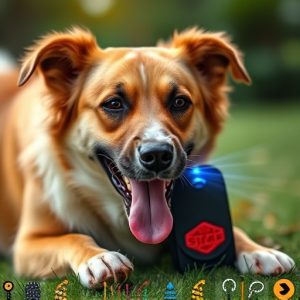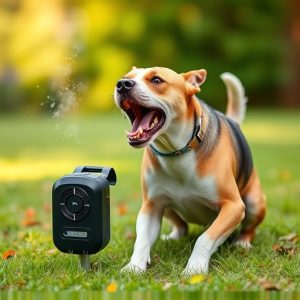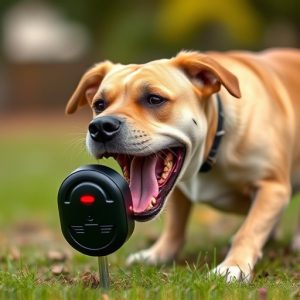Ultrasonic Dog Deterrents: Science-Backed Effectiveness & Compliance Testing
Ultrasonic dog repellents, effective yet harmless, rely on Dog Repellent Device Compliance Testing t…….
Ultrasonic dog repellents, effective yet harmless, rely on Dog Repellent Device Compliance Testing to ensure safety and efficacy. These tests assess sound pressure levels, preventing hearing damage, and confirm their ability to deter dogs without harm. Rigorous laboratory examinations cover acoustic performance, durability, and non-target effects, ensuring compliance with FDA regulations. Regular testing is vital for maintaining optimal device performance, addressing weather, interference, or wear issues early on. Pet owners benefit from reliable, safe solutions for peaceful coexistence between pets and their environments.
“Unleash a silent yet powerful ally in your pest control arsenal with ultrasonic dog deterrents. This innovative technology offers a non-invasive solution for keeping dogs away from unwanted areas. In this comprehensive guide, we’ll explore the science and effectiveness of these devices, starting with an in-depth look at how they work and their benefits. We’ll then delve into crucial aspects such as compliance testing, ensuring product safety and reliability. By understanding the mechanics and practical application, you can make informed decisions regarding ultrasonic dog repellent devices.”
- Understanding Ultrasonic Dog Deterrent Devices
- The Science Behind Ultrasound and Dogs
- Compliance Testing for Dog Repellent Devices
- <a href="#implementing-and-evaluating-the-effectiveness-of-ultrasonic-dog-deters”>Implementing and Evaluating the Effectiveness of Ultrasonic Dog Deters<EOS_TOKEN>
Understanding Ultrasonic Dog Deterrent Devices
Ultrasonic dog deterrents are innovative devices designed to keep dogs away from specific areas without causing them harm. These repellents emit high-frequency sound waves that are inaudible to humans but can be unpleasant for canines, encouraging them to stay clear of the treated zones. The technology behind these devices is based on understanding canine behavior and their sensitivity to certain frequencies.
Compliance testing is a crucial aspect of ensuring these dog repellent devices are effective and safe. Rigorous tests assess their ability to deter dogs while adhering to relevant safety standards. This includes evaluating the intensity and range of ultrasonic emissions, ensuring they remain within harmless limits for both pets and humans. Such testing is vital in validating the product’s performance and providing peace of mind for consumers seeking humane dog control solutions.
The Science Behind Ultrasound and Dogs
Ultrasonic waves, with their high-frequency sound, have been found to be an effective tool in repelling dogs. While humans typically cannot hear sounds above 20 kHz, many dog breeds possess a heightened sense of hearing that allows them to detect and respond to ultrasonic frequencies. This is the principle behind ultrasonic dog deterrents—devices designed to emit high-frequency sound waves that are unpleasant for canines but harmless to humans and other animals.
Compliance testing for these dog repellent devices is crucial to ensure they operate within safe sound pressure levels, as prolonged exposure to even low-intensity ultrasonic noise can cause temporary hearing damage in dogs. Such testing verifies the product’s effectiveness while adhering to safety standards, providing pet owners with peace of mind that their choice of deterrent is both humane and compliant with relevant regulations.
Compliance Testing for Dog Repellent Devices
Dog Repellent Device Compliance Testing is a critical process that ensures these devices meet safety and efficiency standards. It involves rigorous assessments to verify that the ultrasonic waves emitted are within acceptable frequency ranges, safe for dogs, and effective in deterring them from specific areas. Independent testing laboratories play a pivotal role here, conducting thorough examinations to confirm compliance with relevant regulations, such as those set by the FDA or similar bodies.
These tests cover various aspects, including acoustic performance, durability, and potential non-target effects on other animals. By subjecting the devices to diverse conditions and scenarios, testers ensure they function optimally under different circumstances. The goal is to provide pet owners with reliable, safe, and effective dog repellent solutions that align with industry standards, thereby promoting peace of mind and harmonious coexistence between pets and their environments.
<section id="implementing-and-evaluating-the-effectiveness-of-ultrasonic-dog-deters”>
Implementing and Evaluating the Effectiveness of Ultrasonic Dog Deters<EOS_TOKEN>
Implementing an ultrasonic dog deterrent is a straightforward process, typically involving placement near areas dogs frequent and setting the device to emit high-frequency sound waves. These sounds are inaudible to humans but can be very distressing for canines, encouraging them to avoid the treated zones. Regular evaluation of the system’s effectiveness is crucial. Dog repellent device compliance testing should be conducted periodically to ensure the device continues to function as intended and remains a reliable solution.
This evaluation process includes checking the device’s sensitivity control, ensuring it triggers accurately at the set frequency range for dogs but not for humans or other pets. Additionally, assessing the range and consistency of the ultrasonic emission is vital. Over time, factors like weather conditions, interference from neighboring devices, or wear and tear can impact performance. Regular testing helps identify any issues early on, allowing for prompt adjustments or device replacement if necessary, thereby maintaining the deterrent’s overall efficiency in keeping dogs at bay.
Ultrasonic dog deterrents offer a humane and effective solution for managing canine behavior, but it’s crucial to understand their mechanics and select products that undergo rigorous Dog Repellent Device Compliance Testing. By harnessing the power of high-frequency sound waves, these devices create an invisible barrier that disrupts dogs’ sense of smell and hearing, encouraging them to stay away from treated areas. When choosing an ultrasonic dog deterrent, look for products certified by reputable testing agencies to ensure their safety and reliability. Responsible use of these tools, combined with positive reinforcement training, can help maintain a peaceful environment for both pets and people.


